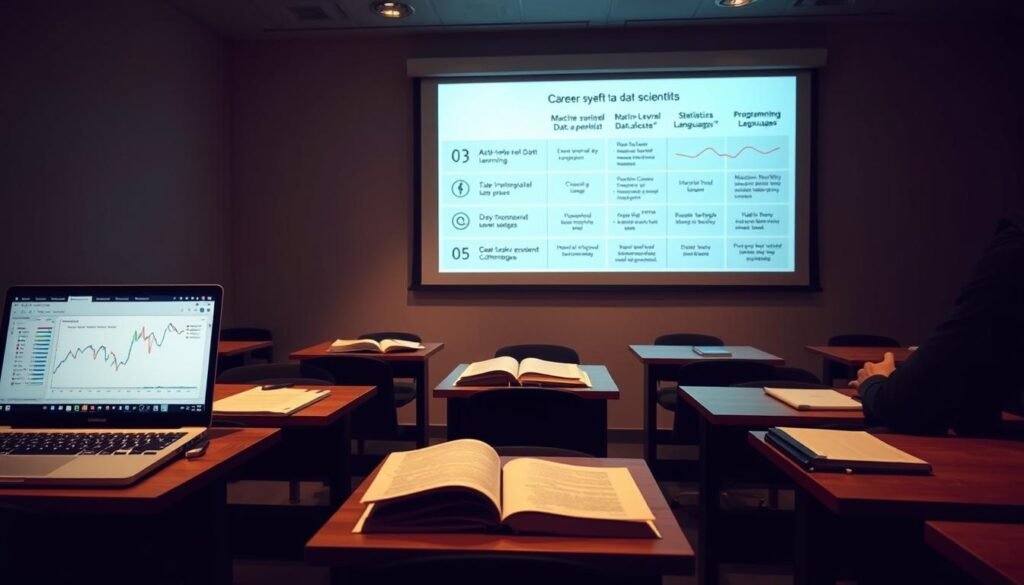Every day, businesses generate mountains of information. But who transforms this chaos into actionable insights? Enter the world of data-driven problem solvers – professionals who blend technical expertise with strategic thinking to shape decisions. The US Bureau of Labor Statistics projects 36% job growth for these roles through 2031, reflecting their critical role in modern industries.
My journey into this field began with a simple question: “Can numbers tell stories that change outcomes?” After years in analytics, I realized merging coding skills with business acumen creates unparalleled value. This guide will walk you through the essentials of how to be a data scientist, from foundational skills to advanced techniques.
You’ll discover why professionals in this domain earn median salaries exceeding $103,500 annually. We’ll explore tools like Python and TensorFlow, along with real-world applications of machine learning models. Whether you’re transitioning careers or leveling up, understanding these components is crucial.
Table of Contents
Key Takeaways
- Data professionals enjoy 36% projected job growth through 2031
- Median salaries surpass $103,500 for experienced roles
- Technical skills merge with business strategy for maximum impact
- Python and machine learning frameworks form core competencies
- Real-world problem-solving defines daily responsibilities
My Journey into Data Science
Transforming raw numbers into strategic insights became my calling while working on early analytics projects in my career. While others saw spreadsheets, I recognized patterns whispering stories about customer behavior. This revelation steered me toward data science, a field blending coding precision with business strategy like no other discipline.
Why I Chose Data Science
Many consider roles in pure analytics or software engineering, but I craved the end-to-end impact of building solutions. Predictive analytics offered something unique: the power to shape decisions before problems escalated. Unlike traditional roles, this domain rewards curiosity, every dataset holds unanswered questions waiting for creative problem solvers.
I’m reminded of deep thinkers, such as my colleague Suman Halder, whose curiosity and thoughtful questions push us to see beyond the obvious. 😊
As a data engineer, being able to dive deep and truly understand the data is essential, because when someone like Suman starts asking questions, surface-level knowledge just won’t cut it.
Also Read: Why is Data Important: Unlock the Power of Data
My Early Challenges and Lessons
My first Python script crashed spectacularly. Statistical concepts like p-values initially felt like deciphering hieroglyphics. Through nightly coding sessions and real-world projects, patterns emerged. Computer science fundamentals, especially algorithms, became my compass for navigating complex machine learning frameworks.
Mentors emphasized one truth: technical skills grow through iteration, not perfection. Embracing messy datasets and flawed models taught me more than any textbook. Each challenge deepened my appreciation for how machine learning transforms theoretical math into actionable business intelligence.
Understanding the Role of a Data Scientist
Behind every data-driven decision lies a meticulous process of analysis and insight generation. My days revolve around transforming raw information into strategic roadmaps, a balance of technical precision and business storytelling.

Core Responsibilities and Daily Tasks
Mornings start with scrubbing datasets, removing inconsistencies that could skew results. Afternoons involve building learning models to predict customer behavior or optimize supply chains. Key tasks include:
- Collaborating with stakeholders to define measurable objectives
- Designing algorithms that automate repetitive processes
- Translating statistical findings into visual dashboards
Success requires mastering programming languages like Python and SQL. These tools help manipulate large datasets efficiently. A typical project involves 60% data preparation, 30% model refinement, and 10% presenting actionable insights.
Essential Tools and Technologies
The technological toolkit evolves constantly. Here’s what dominates current workflows:
| Tool | Primary Use | Industry Adoption |
|---|---|---|
| Python | Machine learning development | 82% of teams |
| R | Statistical analysis | 47% in research roles |
| SQL | Database querying | 91% across sectors |
| TensorFlow | Deep learning frameworks | 68% in tech firms |
While a bachelor degree in computer science or a related field provides foundational knowledge, practical skills often come from hands-on projects. I’ve found that combining formal education with self-taught techniques accelerates becoming data-fluent in fast-paced environments.
How to be a Data Scientist: Steps and Strategies
The path to expertise combines structured learning with relentless curiosity. When I first explored analytical roles, mentors emphasized three pillars: mathematical foundations, technical execution, and business communication. Master these, and you’ll transform raw information into strategic assets.
- Build Core Competencies
Start with Python programming and statistics. Online platforms like Coursera offer courses where I practiced real-world scenarios. Key focus areas:
- Probability distributions
- SQL query optimization
- Basic machine learning concepts
- Practice Translating Numbers
Early projects taught me to visualize data effectively. Tools like Tableau and Matplotlib turn abstract figures into compelling narratives. One dashboard I created reduced a client’s decision-making time by 40%. - Implement Continuous Learning
Weekly algorithm challenges on Kaggle keep skills sharp. I allocate 15% of my work hours to exploring new libraries like PyTorch. - Leverage Project-Based Growth
Collaborate on open-source initiatives or freelance gigs. My breakthrough came from optimizing a supply chain model using time-series analysis, now featured in an industry case study. - Refine Through Feedback
Join communities like Data Science Central. Peer reviews of my clustering techniques revealed blind spots in outlier detection methods.
Structured roadmaps accelerate progress, but adaptability determines long-term success. Revisit your strategy quarterly, aligning skills with emerging trends in artificial intelligence and predictive analytics.
AI is the new electricity.
Educational Pathways and Alternative Learning Options
Choosing the right educational path feels like standing at a crossroads with multiple viable routes. During my career transition, I weighed structured programs against self-guided learning. Each option offers distinct advantages depending on your timeline, budget, and learning style.

Traditional Degrees vs. Bootcamps
My master’s program provided deep theoretical knowledge in statistical modeling, skills I still use daily. Universities offer comprehensive curricula covering advanced machine learning concepts and research opportunities. However, four-year degrees demand significant time and financial investment.
Bootcamps condensed two years of material into 12 intensive weeks. While they excel at teaching practical coding skills, I noticed gaps in foundational math understanding among peers who skipped formal education. Consider this comparison:
| Pathway | Duration | Cost | Skill Focus |
|---|---|---|---|
| Bachelor’s Degree | 4 years | $60k+ | Theory & broad competencies |
| Bootcamp | 3-6 months | $15k | Applied programming |
| Online Courses | Self-paced | $50-$500 | Specialized techniques |
Online Courses and Self-Directed Growth
Platforms like Coursera helped me master niche areas like neural networks without quitting my job. Certifications from reputable institutions carry weight, my IBM Data Science credential opened doors early in my career.
I allocate 30 minutes daily to studying new algorithms through blogs and documentation. This habit keeps my toolkit current despite rapid technological changes. Pairing structured courses with hands-on projects creates a powerful synergy for skill development.
Mastering Essential Technical Skills
Cracking complex datasets felt like learning a new language, until I discovered systematic approaches to technical mastery. My breakthrough came when I stopped chasing perfection and focused on practical application of programming concepts.
Programming Languages and Statistical Analysis
Python became my gateway drug to problem-solving. I combined Codecademy’s interactive courses with real-world projects, like analyzing Spotify’s API to predict song popularity. Key tools in my arsenal:
- Jupyter Notebooks for iterative testing
- Pandas for wrangling messy datasets
- Scikit-learn for implementing basic algorithms
Statistical literacy proved equally vital. Understanding distributions helped me explain why certain models outperformed others. Weekly practice with Kaggle datasets sharpened my ability to spot anomalies.
Data Visualization and Machine Learning Techniques
Tableau transformed how I communicate findings. One dashboard visualizing retail foot traffic patterns convinced executives to relocate three stores. For machine learning, I start simple, linear regression before neural networks.
Regular participation in hackathons forced me to integrate tools like Matplotlib with TensorFlow. As Google’s Chief Economist Hal Varian noted:
The ability to take data, to understand it, process it, extract value from it, is going to be a hugely important skill.
I dedicate 20% of my workweek to exploring emerging libraries. This habit turned PyTorch from a mystery into my preferred framework for deep learning projects. Continuous growth in this field isn’t optional, it’s the price of relevance.
Gaining Practical Experience in the Field
Translating classroom concepts into business impact transformed my understanding of analytics. Real-world applications revealed gaps no textbook could address, like handling incomplete datasets or communicating technical findings to non-technical teams.
Internships, Projects, and Competitions
My first breakthrough came through a fintech internship analyzing transaction patterns. Cleaning millions of records taught me more about statistics than any lecture. Later, Kaggle competitions sharpened my ability to optimize models under tight deadlines. Three strategies accelerated my growth:
- Building end-to-end projects (e.g., predicting housing prices using Python)
- Contributing to open-source repositories on GitHub
- Participating in time-bound hackathons to simulate workplace pressures
These experiences forced me to master new languages like R for specialized statistical analysis while reinforcing core computer science principles.
Building a Professional Network
Connections unlocked opportunities I never found on job boards. At a local meetup, I collaborated on a healthcare analytics initiative that became my portfolio centerpiece. Key networking tactics:
- Engaging in LinkedIn groups focused on machine learning trends
- Volunteering for pro-bono projects with established professionals
- Seeking feedback on code repositories from senior developers
One mentor’s advice reshaped my approach:
Your GitHub is your resume, curate it like a gallery, not a storage unit.
This mindset helped me transition from academic exercises to production-ready solutions.
Navigating the Data Science Career Landscape
Career paths in analytics resemble dynamic ecosystems, constantly shifting with technological breakthroughs and market demands. During my transition from academia to industry, I discovered opportunities spanning healthcare diagnostics to climate modeling. Employers increasingly seek professionals who blend technical rigor with sector-specific knowledge.
Three industries currently drive demand: fintech (fraud detection), e-commerce (personalization algorithms), and energy (predictive maintenance). I prioritize roles where analysis directly impacts strategic decisions, like optimizing hospital resource allocation or reducing manufacturing waste. Emerging trends in edge computing and ethical AI create new niches worth exploring.
When evaluating opportunities, I assess three factors:
- Alignment with my expertise in time-series forecasting
- Company investment in continuous education
- Potential to solve novel problems at scale
The competitive landscape rewards specialization. My breakthrough came by focusing on supply chain analytics, a decision that tripled interview requests. As Netflix’s former VP of Product put it:
Data without context is just noise.
Adaptability remains crucial. I regularly update my LinkedIn profile with certifications like Google’s Cloud Professional Machine Engineer credential. Networking through industry-specific Slack groups has uncovered unadvertised roles at cutting-edge startups.
Staying Updated with Industry Trends
The analytics landscape evolves faster than most industries. When I implemented my first neural network five years ago, tools like AutoML and ethical AI frameworks didn’t dominate workflows. Today, they’re reshaping how professionals interact with models and datasets.
Emerging Tools and Technologies
MLOps platforms now bridge the gap between prototype and production. I’ve integrated tools like MLflow and Kubeflow to streamline model deployment cycles. Current game-changers include:
- Automated machine learning (AutoML) for rapid prototyping
- Responsible AI toolkits addressing bias detection
- Real-time analytics engines like Apache Flink
| Technology | Purpose | Adoption Rate |
|---|---|---|
| Hugging Face | NLP model sharing | 58% in tech firms |
| Vertex AI | Managed ML pipelines | 41% enterprise use |
| Great Expectations | Data validation | 33% across sectors |
Continuous Learning and Professional Development
I allocate 10% of my work hours to skill updates. Weekly webinars from Fast.ai keep me current with deep learning advancements. Certifications like Google’s Professional Machine Learning Engineer validate expertise in new methodologies.
Adapting to shifting datasets requires flexible strategies. When GDPR changed data handling rules, I redesigned preprocessing steps using PySpark. As Stanford’s Fei-Fei Li observes:
AI’s future depends on democratizing education while maintaining rigor.
Three practices sustain my growth:
- Reverse-engineering cutting-edge research papers
- Contributing to GitHub communities focused on MLOps
- Testing beta features in TensorFlow Extended
Every technological step forward creates opportunities to refine analytical work. Staying current isn’t optional, it’s how we maintain relevance in this dynamic field.
Conclusion
Charting a course through numbers reveals patterns that shape industries. My journey began with a bachelor’s degree in computer science, but true mastery emerged from hands-on projects that turned theories into actionable intelligence. Each career decision, from selecting courses to tackling Kaggle competitions, sharpened my ability to transform raw information into strategic value.
Successful professionals blend formal education with relentless skill development. While my degree provided foundational knowledge, self-taught techniques in machine learning frameworks proved equally vital. Platforms like Coursera accelerated my growth, proving that learning never stops in this dynamic field.
Staying competitive demands awareness of emerging trends. Ethical AI frameworks and automated tools now redefine daily workflows, requiring adaptability. One truth remains: business intelligence thrives when technical skills meet curiosity.
Today marks your first step. Pursue that certification. Analyze a public dataset. Every day offers opportunities to refine your craft. The patterns await, what story will your numbers tell?
FAQ
What educational background do employers prioritize for data science roles?
Employers often seek candidates with degrees in computer science, statistics, or related fields. However, I’ve seen peers succeed through bootcamps like General Assembly or online certifications from Coursera and IBM. Practical skills in programming languages like Python or R matter more than formal credentials alone.
Which programming languages are critical for building machine learning models?
I prioritize Python for its libraries like TensorFlow and scikit-learn. SQL is essential for database management, while R remains valuable for statistical analysis. Familiarity with Julia or Scala can also enhance your versatility in handling large datasets.
How important is domain knowledge in data science careers?
Domain expertise separates good data scientists from great ones. Whether working in healthcare, finance, or tech, understanding industry-specific challenges helps tailor machine learning models and visualize data effectively. I’ve found that combining technical skills with business acumen drives impactful decisions.
Can I transition into data science without prior coding experience?
Yes, but expect a steep learning curve. Start with free resources like Kaggle’s micro-courses or Codecademy. I built my foundational knowledge through projects, like analyzing public datasets on GitHub, to practice cleaning data and applying statistical methods.
What tools should I master to stay competitive in this field?
Beyond programming languages, learn platforms like Tableau for visualization, Apache Spark for big data processing, and cloud services like AWS or Azure. Tools such as Jupyter Notebooks and Git are non-negotiable for collaboration and version control in real-world projects.
How do I showcase my skills if I lack professional experience?
Create a portfolio highlighting personal or open-source projects. For example, I published case studies on Medium detailing how I optimized algorithms or visualized trends using Matplotlib. Participate in Kaggle competitions to demonstrate problem-solving abilities with raw datasets.
What soft skills complement technical expertise in this role?
Communication is key. Translating complex results into actionable insights for non-technical stakeholders has been vital in my career. Critical thinking, curiosity, and adaptability also help navigate evolving trends like generative AI or ethical AI frameworks.
How do I keep up with rapid changes in machine learning trends?
Follow thought leaders on LinkedIn, subscribe to journals like Towards Data Science, and attend conferences like NeurIPS. I dedicate weekly time to experiment with emerging tools, recently, diving into Hugging Face’s transformer models to stay ahead in NLP advancements.














